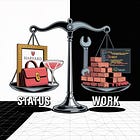Sex difference denial hurts excellent women
It is about standard deviations, not averages
Welcome. I’ve been circling around this particular sacred cow for most of this year, and it’s finally time to butcher it. I have linked several papers instead of footnoting them to keep them visible for everyone. The paywalled section of this is a deep dive into how this lie affected me and the civilizational implications of denying sex differences, but the structural argument is available to all.
I. Introduction
The denial of sex-based and evolutionarily determined differences is the foundational lie of the professional managerial class. I’m aware that I can be accused of “biological determinism,” but that rebuttal is lazy - sex differences found across cultures in average behaviors shape outcomes, though the PMC insists that they’re the result of discrimination.
Not only does the PMC writ large need this to be true for its class project, but women also need this to be true to justify their credential-based dominance of whole sectors of the economy. It’s also the basis of the claim that women are underrepresented in technical roles because of stereotype threat — that men assume they can’t do it, so they decide there’s no point in trying. This is again a way to pretend that outcomes have nothing to do with one’s choices or abilities.
II. The zombie lie: all sex differences are “socialized” and the denial of evolution
We’ve all been in social settings where at least one woman will flippantly state that all differences between men and women are socialized. There’s never been empirical evidence to back this.
This zombie lie came out of women’s studies departments in the 80s and 90s and spread like a virus among professional-class women. The socialization theory is a bastardization of John Locke’s idea that we are born blank slates. However, Locke made this claim before the advent of the modern scientific method and before Darwin’s theories of natural selection, which shape animal behavior.
Behavior is shaped by both nature and socialization, but most of our traits are inherited. including physical, mental, and emotional characteristics. Environment matters, but much of behavior is shaped by genes, as many twin studies have shown. Ironically, the same people who deny biologically based sex differences also push epigenetics, which posits that trauma is passed down over generations, to explain disparities between groups.
The denial of sex differences is a denial of science and of evolution. When the religious right attacked evolution, the left claimed to defend science. Yet, professional class women need evolution to be false to justify demands for parity in areas to which many are unsuited by innate ability.
This denial also erases variance among women. Female excellence is pathologized: outliers are called pick-mes seeking male attention or dismissed as aberrant. Some women are wired to be highly analytical, like several of my readers, and are not neurodivergent because of it. Neurodivergence is asserted as a deviation from a curve, but the term is used to flatten differences as meaningless. Anyone can claim to be neurodivergent. There is no barometer, and that is the point.
I have worked with women in analytical roles who bully others into acquiescing to idiocy by claiming sexism when questioned. I’ve been told I’m neurodivergent when I wrote about the intellectual poverty of women’s society, as though I am broken. But calling me neurodivergent is an admission that most women prefer social-relational talk to abstraction, proving my point about natural differences among women.
The denial of female excellence via the zombie lie of socialization allows statistically average women to bully those who are more capable. I cannot mince words here. The truth is rude.
III. Hierarchies are inevitable, but some are built on lies
What happens when you build modern society on a lie?
Managerial capitalism is a reorganization of economic activity centered on expertise, efficiency, and bureaucracy. Its expansion required women to enter the workforce. Betty Friedan was not describing liberation so much as reacting to managerial capital’s demand for more white-collar labor. The entire project rests on the fiction of interchangeability: if men are not graduating in sufficient numbers for credential-gated jobs, women can fill the gap.
The managerial state cannot function without hierarchies. It replaced older hierarchies of ability with new ones based on credentials and victimhood. These are the hierarchies feminism has both created and obscured.
Women have competed covertly for millennia. We pretend all women are equal while knowing where we fall in the pecking order. In the workplace, this competition manifests as credentialism and compliance, enforced through extensive bureaucracy and arbitrary requirements. Status games are introduced under the guise of meritocracy. Feminism is an adaptive rationalization of an ingrained behavior.
Feminism also created a hierarchy of victimhood. Men are placed at the bottom, and white women float to the top while gesturing at centering women of color. This is called the progressive stack. The more oppressed one is, the more moral authority they carry. They cannot be questioned. This hierarchy of victimhood is a feature, not a bug. It is necessary for the professional managerial class to maintain moral authority and justify its social engineering.
IV. Statistical illiteracy is normal for the PMC
Most people struggle to interpret distributions, probability, and variance. The PMC treats these concepts as justifications for bigotry. The ostensibly educated class is largely statistically illiterate, which is inexcusable for people claiming to be experts.
Abilities are not evenly distributed. Many normal distribution curves for behaviors and traits are well-documented across cultures. Analytical ability, conscientiousness, and openness all tend to follow distribution curves, rather than being flat lines. To deny this is to deny statistical principles.
Critics sometimes counter that masculine and feminine curves largely overlap. That is true, but the crucial distinction is this: there are more men at the extremes of analytical ability than women. There are many men who are less intelligent than the average woman, but also many who surpass her. Feminism cannot admit this.
From one of the most cited papers on sex differences:
Finally, the omnipresent claim that sex differences in mathematics result from early socialization (i.e., parents and teachers inculcating a “math is for boys” attitude) fails empirical scrutiny. One cannot assert that socialization causes girls to opt out of math and science when girls take as many math and science courses as boys in grades K–12, achieve higher grades in them, and major in college math in roughly equal numbers to males. Moreover, survey evidence of parental attitudes and behaviors undermines the socialization argument, at least for recent cohorts (Ceci & Williams, 2010).
Ceci SJ, Williams WM. Sex Differences in Math-Intensive Fields. Curr Dir Psychol Sci. 2010 Oct 1;19(5):275-279. doi: 10.1177/0963721410383241. PMID: 21152367; PMCID: PMC2997703.
The very existence of analytically exceptional women must be explained away as an aberration in the name of sisterhood. Women who succeed in technical fields are often overlooked or treated as statistical anomalies, rather than examples of variance.
If statistical variance is accepted, equality of outcome is impossible. This is why variance is denied: acceptance would undermine PMC authority and the institutions built on engineered equality. If variance is real, natural hierarchies are inevitable. Hierarchies based on ability cannot be reconciled with feminism’s egalitarian claims.
Life outcomes cannot be reduced to a single variable of discrimination. Attitudes are self-reported and cannot be measured. Scientific rigor demands controlling for multiple variables to separate correlation from causation. The professional class’s reliance on single-variable explanations is not analysis but blindness to probability. It leaves no room for pattern recognition, which requires probabilistic thinking. Ironically, the current wave of technological disruption is founded on probability.
For paid subscribers: deep cuts
Analytical ability matters; credentialism is a form of female hierarchy, and how I came to succeed.
V. Analytical ability as civilizational glue
Keep reading with a 7-day free trial
Subscribe to Radically Pragmatic to keep reading this post and get 7 days of free access to the full post archives.






